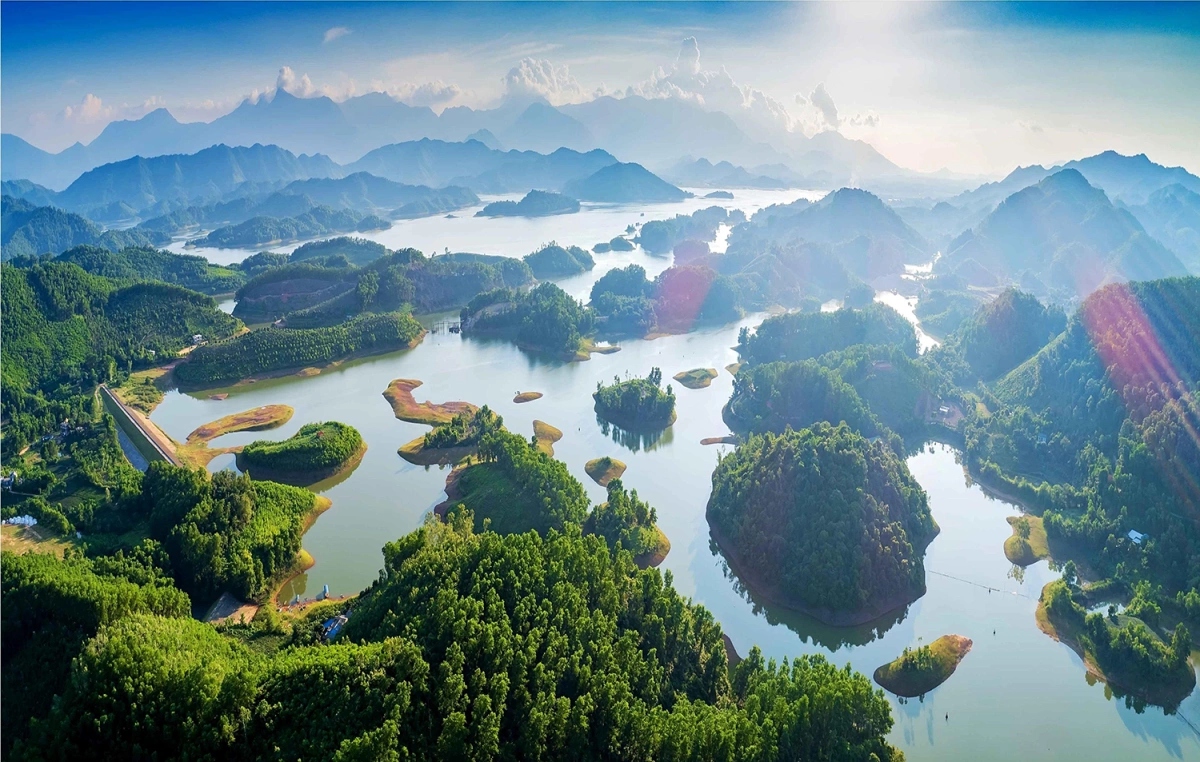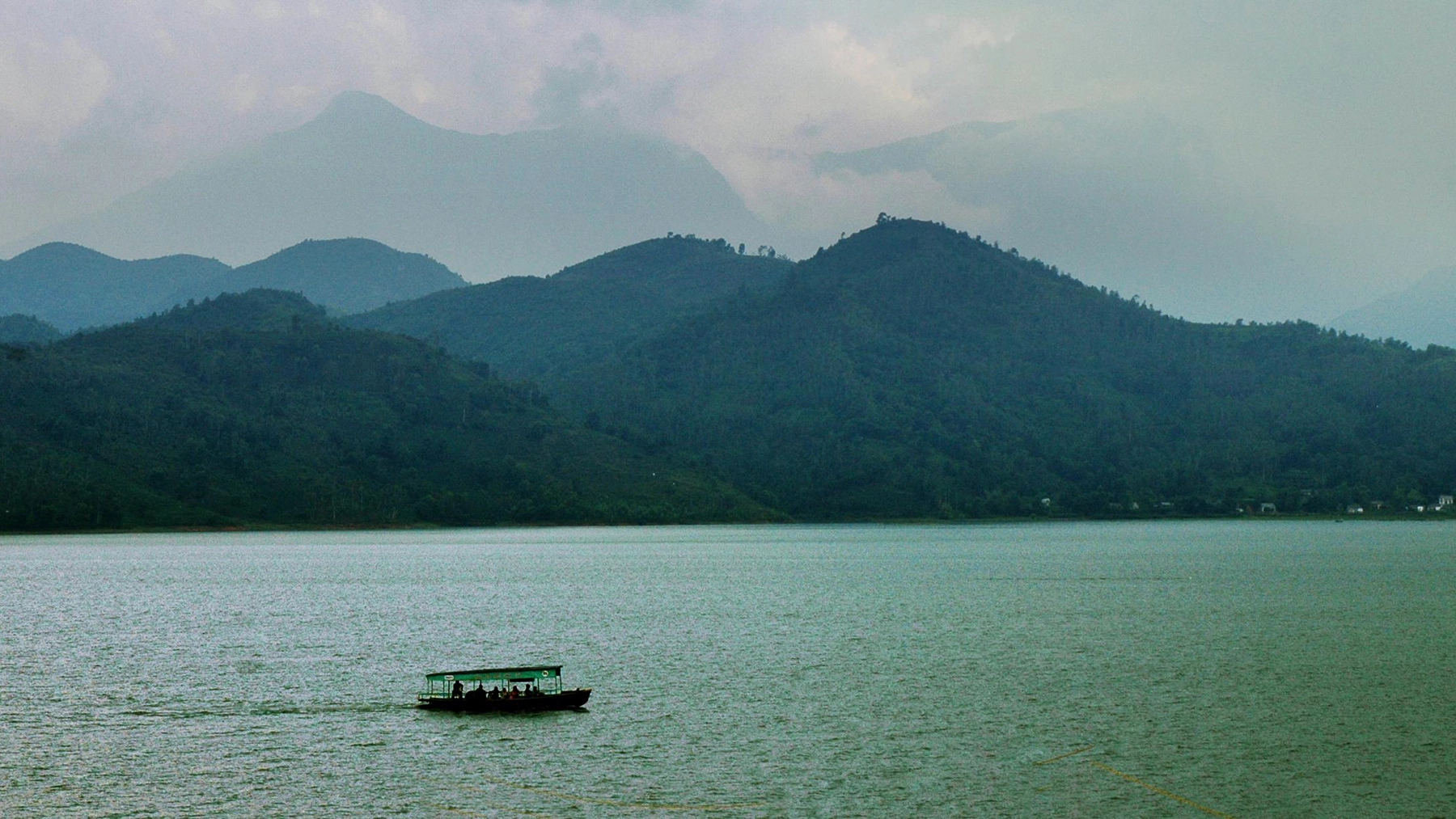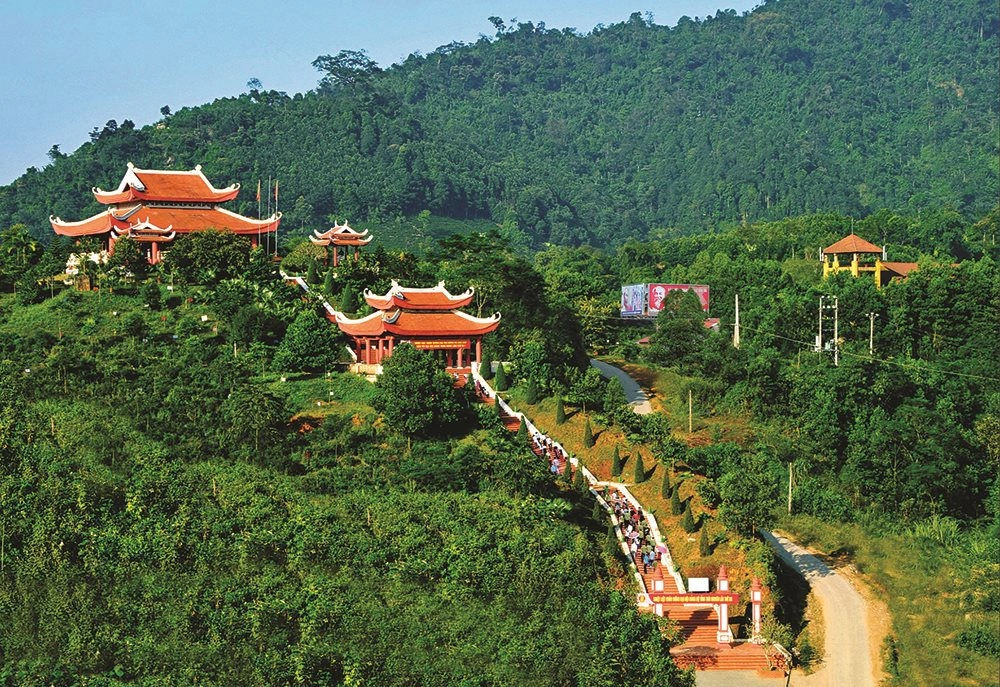
Thai Nguyen is approximately 80 kilometers away from Hanoi, as well as the provinces of Vinh Phuc, Tuyen Quang, Bac Kan, Lang Son, Bac Giang. It features various revolutionary bases and scenic spots.
Thai Nguyen experiences a hot and humid tropical monsoon climate, characterized by four seasons of the northern region. Due to the varying terrain of plains, midlands, and mountains, different areas of Thai Nguyen have varying temperatures. The average temperature in the hottest month (June) is 28.9 degrees Celsius, while January averages 13.7 degrees Celsius.
The first months of the year are the time when traditional and spiritual festivals take center stage, including the Doom Temple, Long Tong Temple, Hich, Hang Pagoda, and Mount Van-Mount Vo festivals. During the summer, the tea hills are vibrant green and provide a picturesque backdrop for tourists to explore and capture photographs.
Nui Coc Lake

Nui Coc Lake tourist area is a natural landscape situated in the southern part of Dai Tu District, about 15 kilometers from Thai Nguyen's capital city. The area features 89 islands, and visitors can enjoy activities such as basket boat ride, exploring the Fairy Tale House Underworld, visiting the Three Pine Trees Cave or the Golden Waterfall Sacred Pagoda.
Ghenh Che Lake
Located in Binh Son Commune of Song Cong City, approximately 20 kilometers from Thai Nguyen's capital, Ghenh Che Lake is an irrigation lake built in 1986. Covering an area of about 80 hectares, it consists of 45 peninsulas. The lake has gained popularity among tourists as an eco-tourism and fishing destination, particularly on weekends.

Recently, new tourism services have been introduced, including boat rides to explore the lake, dining options, camping facilities, and picnic areas.
Kem Stream and La Bang Tea Area
Kem Stream is in La Bang Commune, Dai Tu District, approximately 35 km from Thai Nguyen City. The stream originates from the top of Tam Dao Mountain. Visitors can follow the rapids along the stream and admire the cascading waterfalls that resemble terraced fields. La Bang is renowned for its tea plantations, where visitors can explore the lush green tea hills, take photos, and experience tea picking with the locals.

Additionally, the Craft Village Information Center showcases handicraft products from the La Bang Tea Cooperative, offering visitors a chance to savor Thai Nguyen's tea specialties.
Phoenix Cave - Mo Ga Stream
This national-ranked scenic spot is in Phu Thuong Commune of Vo Nhai District. Phoenix Cave is associated with the legend of a pair of phoenix birds. The cave entrance is positioned atop a mountain at an altitude of approximately 500 meters. Inside the cave, visitors can explore three floors adorned with centuries-old stalactites forming intriguing shapes on the cave's ceiling. Water cascades down from the cave mouth, creating multiple small waterfalls.
At the foot of Phuong Hoang Mountain, Mo Ga Stream flows naturally, offering clear and refreshing water. The Phuong Hoang Cave tourist area provides services such as restaurants, a swimming pool, motels, event organization, and souvenir shops.

Hang Pagoda
Hang Pagoda, a national monument since 1999, is about 2 kilometers from the center of Thai Nguyen. Situated within Chua Hang Mountain, formerly known as Hoa Trung Rock Mountain and Long Tuyen Mountain, this site houses Hang Pagoda Cave, also known as Tien Lu Cave, adorned with stunning stalactites.
Inside the cave, a Buddha shrine enhances the spiritual ambiance. The cave entrance cliff features an ancient Chinese couplet: "Natural scenery is the most beautiful. The beauty created by humans is unmatched." Chinese poems carved by renowned artists Vu Quynh, Dang Nghiem (15th century), and Cao Ba Quat (19th century) can also be admired along the cave walls.
Duom Mountain - Duom Temple
Duom Mountain, formerly known as Diem Son, is renowned for its allure, ranking as a scenic gem of Thai Nguyen in the Dai Nam Comprehensive Encyclopaedia, the official geographical record of Vietnam's Nguyen Dynasty compiled in the late 19th century. The mountain's six rocky peaks, resembling dragon heads from a distance. Draped in ancient moss, the vertical cliffs are adorned with ancient moss.
At the northeastern foot of the mountain, a distinguished temple dedicated to the esteemed Duong Tu Minh graces the landscape. Minh, a leader of Phu Luong government and the consort of two Ly kings, earned numerous merits while safeguarding the northern border of Vietnam. Duom Temple was designated a national relic in 1993. The Duom Temple Festival takes place annually on the sixth day of the first lunar month.
ATK Dinh Hoa special national relic

During the resistance war against the French colonialists (1946 - 1954), Dinh Hoa, Dai Tu and Phu Luong Districts were designated as the Central Safety Zone - the resistance capital of the country. In 2012, Dinh Hoa was recognized as a special national relic.
Visitors can explore locations such as Khau Ty Hill, home to President Ho Chi Minh's working office, and General Secretary Truong Chinh's office at Na Mon Hill.
Relics of Thai Nguyen Uprising 1917
On August 31, 1917, the Thai Nguyen uprising shook the French colonial government in Indochina. Although unsuccessful, it marked the first time in Vietnam's modern history that an uprising gained power in a province, issued a declaration of independence, raised a national flag, and established its own army.
Today, the sites of the Cong Su Palace, Kho Xanh Barracks, Thai Nguyen Prison, and Gia Sang Defense Line have been classified as national historical monuments, with only ruins remaining.
Museum of Vietnam's ethnic culture
Located in the city center, along the Cau River, the Museum of Cultures of Vietnam's Ethnic Groups houses over 40,000 original documents and artifacts that showcase the traditional culture of 54 ethnic groups in Vietnam. Inside, there are galleries presenting the culture of various ethnic groups, categorized by language groups: Vietnamese - Muong, Tay - Thai, Mong - Dao, Mon - Khmer, Nam Dao, and Chinese - Vietnamese.
Viet Bac Armed Forces Museum
Situated on Quang Trung Street, Tan Thinh Ward, the Viet Bac Armed Forces Museum - Military Zone I exhibits nearly 10,000 original artifacts related to Viet Bac, the primary base and battlefield during the resistance war against the French colonialists. The museum's outdoor display area showcases 28 large-sized artifacts such as aircraft, rockets, radars, and artillery that were instrumental in achieving victories during the resistance wars.
Sticky rice cake
Bo Dau's sticky rice cake chung is a specialty from Phu Luong, Thai Nguyen. It has a thick and wide rice layer and a delicious filling of green bean paste and pork belly. The cake is wrapped in green dong leaves with strings made from the river-leaf creeper found in the Thai Nguyen mountains.

Bo Dau's chung cake is renowned for its vibrant green color. Photo by VnExpress/Nguyen To Quynh
Bo Dau’s chung cake stands out with its vibrant green color from the dong leaves, an aroma mingled with the savory flavor of beans, and the richness of the pork belly. The craft village of Bo Dau in Co Lung Commune, Phu Luong District, is just 8 kilometers away from the city center, making it convenient for visitors to come, enjoy, and purchase these cakes as gifts.
Ash cake
Ash cake is a delicacy cherished by the Kinh, Tay, and San Chay people. The cake is crafted from yellow-flowered glutinous rice, which is soaked in ash water obtained from the burning of sesame and other plants. Chit (thysanolaena latifolia) leaves or dong leaves are used to wrap the cakes.

Ash cakes are best enjoyed cold, dipped in molasses or honey, delivering a potent, slightly pungent taste, and a refreshing sensation on the tongue. These cakes are believed to have cooling properties in digestion, making them a popular choice during holidays.
Five-colored sticky rice
The Tay people in the Dinh Hoa area often prepare five-colored sticky rice fduring holidays and Lunar New Year. This sticky rice variety has five basic colors: red from red sweet gourd, green from ginger leaves or pandan leaves, yellow from turmeric, purple from magenta plant or areca leaves, and the original white.
Locals believe that this rice symbolizes love for mother, respect for father, affection and loyalty between couples, as well as good luck and prosperity.
Nham
Nham is a special salad from Ha Chau Commune, Phu Binh District, typically made during the ripe filling season in the late seventh or early eighth month of the lunar calendar. Nham is made using a combination of 14 ingredients and spices, such as monkfish caught from the Cau River or largescale silver carp, grilled bacon, sesame, roasted peanuts, sour star fruit, fig leaves, unripe sesame leaves, copra, chopped banana tubers, fermented soybean paste, and vinegar.

Cooc mo cakes
Cooc mo is a traditional cake cherished by the Tay and Nung ethnic groups in Thai Nguyen. The cakes are crafted by rolling dong leaves into funnel-like shapes, filled with upland glutinous rice and crushed raw peanuts, tied with rattan rope, and then strung into pairs or small bunches before being boiled for approximately two hours. The cooked cakes showcase the light green color of dong leaves.

Although there is no filling, when savored, one can experience the aromatic and pliant texture of glutinous rice, complemented by the rich and savory taste of peanuts. Depending on personal preferences, these cakes can be enjoyed with sesame salt or honey.
Sticky rice in bamboo tubes
Com lam (sticky rice cooked in bamboo tubes) is made with glutinous rice and cooked in an elongated bamboo tube over charcoal or straw for about an hour. After cooking, the rice is peeled off layer by layer to reveal ivory-white layer wrapping the long rice inside the bamboo tube. Each piece of rice can be enjoyed with sesame salt. The rice tubes can be eaten right away or kept fresh and delicious for up to a week.
Mugwort Cake
Mugwort cake features mugwort, a vegetable commonly grown by the Tay people in home gardens or along streams. The young tops of wormwood are simmered with ash water from the cork tree, and then pounded with glutinous rice that has been cooked into sticky rice until it takes on a dark green color. The mixture is molded into circular shapes by hand. Mugwort cakes can be made with or without fillings.

When a filling is included, it typically consists of crushed green beans, peanuts, or sesame mixed with sugar. The cake boasts a unique taste with the cool, slightly numbing flavor of mugwort leaves blending harmoniously with the aroma of glutinous flour, along with the sweetness of the filling, resulting in a delightful and easy-to-eat treat.
Tea
The soil and climate of Thai Nguyen help tea trees grow well, producing quality tea buds, so it is dubbed the "first-class tea". Tan Cuong tea has the characteristics of clear tea, pale yellow green color and match. When enjoying, one can feel the acrid taste on the tip of the tongue, the sweet aftertaste lingers in the throat, with little bitterness.

Fermented sticky rice paste
This is a local product of the people of Uc Ky Commune in Phu Binh District, made from soybeans and mold fermented from the local glutinous rice. The paste has a dark yellow color, puree, thick like honey, strong aroma of sticky rice and soybean, leaving a sweet taste when eaten. Uc Ky fermented sticky rice can be used to make dipping sauce to accompany dishes in meals or marinate and prepare daily dishes.
Glass noodles
Viet Cuong Hamlet, based in Hoa Thuong Commune of Dong Hy District, has been renowned for nearly 50 years for producing delicious glass noodles. Made from purple galangal root, these noodles have a distinctive brown color without the use of any artificial coloring. The production process adheres to strict standards, resulting in tough, tasty, and hygienic noodles that are not easily crushed.
Chinese black olive
Chinese black olive, a specialty fruit of the people of Ha Chau along the Cau River, boasts a black filling, yellow pulp, and white kernel inside. The fertile soil and favorable climate along the Cau River contribute to its rich taste, characteristic aroma, and thick flesh for Ha Chau’s Chinese black olive. The ripening season typically falls around the seventh and the eight month in the lunar calendar.
The olive is used in a variety of dishes, including braised with meat, fish, cooked with sticky rice, and in its fermented form.
Bitter bamboo shoots
These bamboo shoots are sourced from the Ngan Me forest and are commonly sold at Chua Hang and Dong Hy markets, as well as along National Highway 1B, crossing Gia Bay Bridge. To prepare them, peel the bamboo shoots, boil the whole plant twice, and enjoy them once they are ready.
The easiest way to enjoy them is by boiling with chili salt, where you'll experience their fresh crispiness, slight bitterness, mixed with the savory and spicy taste of chili salt. Bamboo shoots can also be stir-fried or cooked in soup, offering a variety of flavors.
Travelers can choose from a range of hotels in Thai Nguyen City, such as Habana, Da Huong, May Plaza, Indochina, Hai Au, and The King Hotel. Prices per night typically range from VND400,000 to over 1 million (US$17-42).

In the Nui Coc Lake area of Dai Tu District, several hotels are available, including Lake Nui Coc Plaza, Cong Doan Hotel, and Mo Viet Bac Hotel. Prices per room per night in this area range from VND700,000-1.2 million.
Dai Tu District features a glamping site called Mojen Retreat, which has attracted the attention of many young travelers. The retreat offers accommodation for approximately 60 people at a price of VND1.2 million per person per night on weekends, including meals and lodging.
In Song Cong City, visitors can find several hotels, including Green Hotel, Song Cong Hotel, Grace Hotel, and Ngoc Thuy Hotel. Prices per night in this area typically range VND350,000-700,000.
Some homestays are available, such as Hoang Nong Farmstay, Hai Ha Homestay, and Hoang Kim Homestay, with prices ranging around VND300,000-600,000.
Visitors have the option to travel by motorbike, car, or bus. The Hanoi-Thai Nguyen-Bac Kan-Cao Bang Expressway, also known as the new National Highway 3, is a major highway in the northern region. Stretching for 85 kilometers within the province, Highway 3 serves as a vital link connecting Thai Nguyen to Hanoi and other northern provinces. Moreover, Thai Nguyen is situated about 50 kilometers away from Noi Bai Airport, making it convenient for short weekend getaways.
At major bus stations such as My Dinh, Gia Lam, and Giap Bat, various bus companies operate routes to Thai Nguyen. Tickets cost VND70,000-150,000 ($4-6.50). Some recommended bus companies include Thanh Thuy, Duc Phuc, and Lac Hong.
Story by Quynh Mai
Source: Thai Nguyen Tourism Department